外研版必修5第3模块教学设计
- 格式:doc
- 大小:324.00 KB
- 文档页数:19
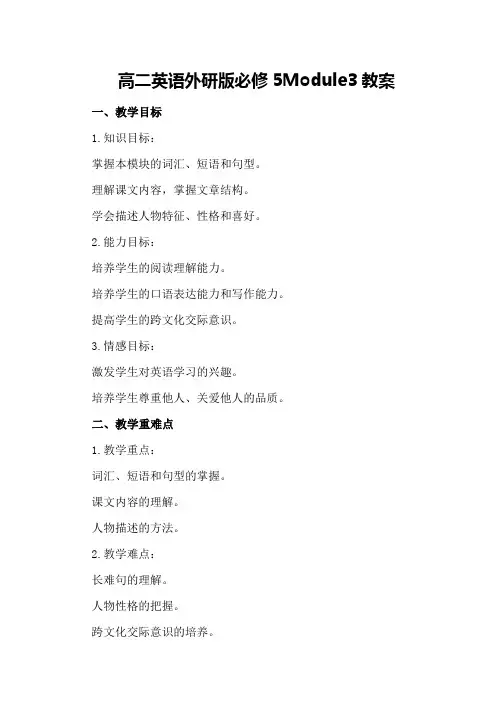
高二英语外研版必修5Module3教案一、教学目标1.知识目标:掌握本模块的词汇、短语和句型。
理解课文内容,掌握文章结构。
学会描述人物特征、性格和喜好。
2.能力目标:培养学生的阅读理解能力。
培养学生的口语表达能力和写作能力。
提高学生的跨文化交际意识。
3.情感目标:激发学生对英语学习的兴趣。
培养学生尊重他人、关爱他人的品质。
二、教学重难点1.教学重点:词汇、短语和句型的掌握。
课文内容的理解。
人物描述的方法。
2.教学难点:长难句的理解。
人物性格的把握。
跨文化交际意识的培养。
三、教学过程1.导入利用图片、视频或故事导入本模块的主题。
提问:你们对这个人有什么印象?他的性格特点是什么?2.词汇教学利用图片、实物或情境教授新词汇。
设计一些练习,让学生在语境中运用新词汇。
3.阅读教学让学生快速阅读课文,了解文章大意。
分析课文结构,找出文章的主题句。
对课文中的长难句进行讲解,帮助学生理解。
设计问题,让学生回答,检查他们对课文的理解。
4.口语教学设计一些角色扮演、讨论或采访活动,让学生在语境中运用所学知识。
教师示范,引导学生模仿。
5.写作教学提供一些写作素材,让学生进行写作练习。
分析优秀范文,让学生了解写作技巧。
批改学生作文,给出修改意见。
6.语法教学分析课文中的语法现象,让学生了解语法规则。
设计一些练习,让学生在语境中运用语法知识。
7.跨文化交际教学分析课文中的跨文化交际现象,让学生了解不同文化背景下的交际方式。
设计一些实践活动,让学生在模拟情境中运用跨文化交际知识。
8.课堂小结对学生的表现给予肯定和鼓励。
四、作业布置1.复习本节课的词汇、短语和句型。
2.完成课文后的练习。
3.准备下一次课的口语活动。
五、教学反思本节课通过多种教学活动,让学生在语境中学习英语,提高了他们的阅读理解能力、口语表达能力和写作能力。
但在教学过程中,仍有一些不足之处,如:1.部分学生对长难句的理解仍有困难,需要加强语法教学。
2.部分学生的口语表达能力较弱,需要加强口语练习。
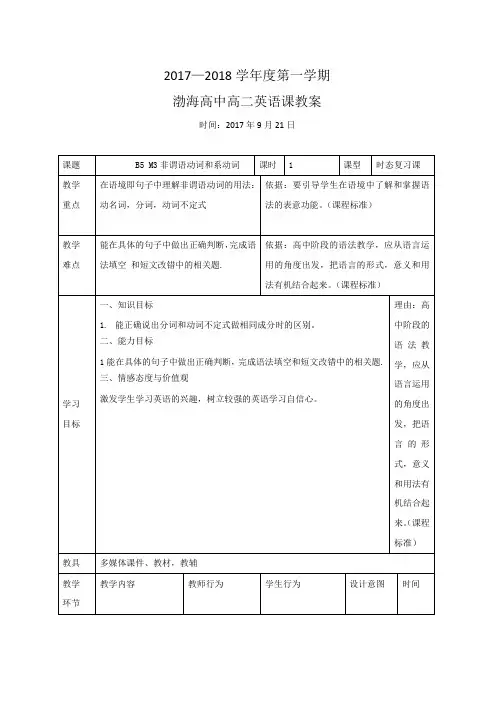
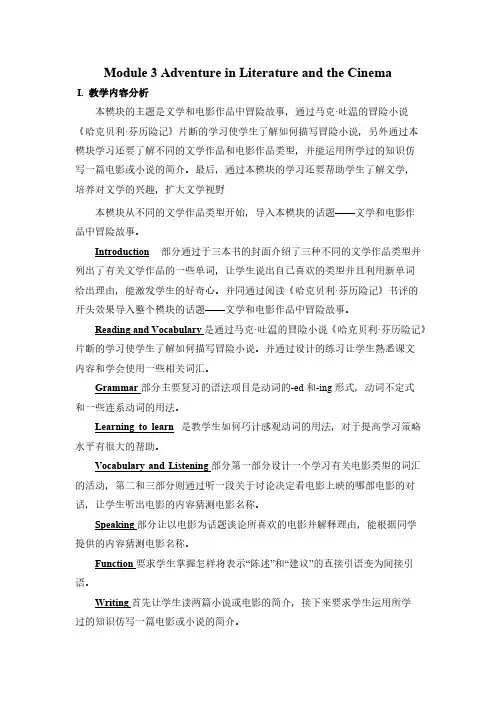
Module 3 Adventure in Literature and the CinemaI. 教学内容分析本模块的主题是文学和电影作品中冒险故事,通过马克·吐温的冒险小说《哈克贝利·芬历险记》片断的学习使学生了解如何描写冒险小说,另外通过本模块学习还要了解不同的文学作品和电影作品类型,并能运用所学过的知识仿写一篇电影或小说的简介。
最后,通过本模块的学习还要帮助学生了解文学,培养对文学的兴趣,扩大文学视野本模块从不同的文学作品类型开始,导入本模块的话题——文学和电影作品中冒险故事。
Introduction 部分通过于三本书的封面介绍了三种不同的文学作品类型并列出了有关文学作品的一些单词,让学生说出自己喜欢的类型并且利用新单词给出理由,能激发学生的好奇心。
并同通过阅读《哈克贝利·芬历险记》书评的开头效果导入整个模块的话题——文学和电影作品中冒险故事。
Reading and Vocabulary是通过马克·吐温的冒险小说《哈克贝利·芬历险记》片断的学习使学生了解如何描写冒险小说。
并通过设计的练习让学生熟悉课文内容和学会使用一些相关词汇。
Grammar部分主要复习的语法项目是动词的-ed和-ing形式,动词不定式和一些连系动词的用法。
Learning to learn是教学生如何巧计感观动词的用法,对于提高学习策略水平有很大的帮助。
Vocabulary and Listening部分第一部分设计一个学习有关电影类型的词汇的活动,第二和三部分则通过听一段关于讨论决定看电影上映的哪部电影的对话,让学生听出电影的内容猜测电影名称。
Speaking部分让以电影为话题谈论所喜欢的电影并解释理由,能根据同学提供的内容猜测电影名称。
Function要求学生掌握怎样将表示“陈述”和“建议”的直接引语变为间接引语。
Writing首先让学生读两篇小说或电影的简介,接下来要求学生运用所学过的知识仿写一篇电影或小说的简介。
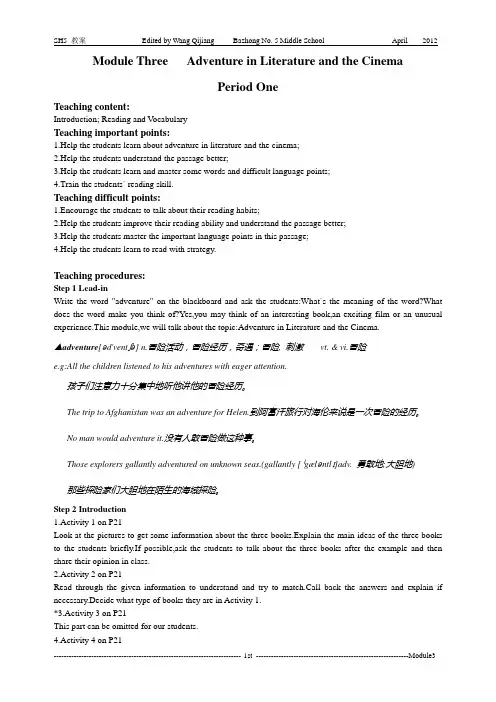
Module Three Adventure in Literature and the CinemaPeriod OneTeaching content:Introduction; Reading and V ocabularyTeaching important points:1.Help the students learn about adventure in literature and the cinema;2.Help the students understand the passage better;3.Help the students learn and master some words and difficult language points;4.Train the students` reading skill.Teaching difficult points:1.Encourage the students to talk about their reading habits;2.Help the students improve their reading ability and understand the passage better;3.Help the students master the important language points in this passage;4.Help the students learn to read with strategy.Teaching procedures:Step 1 Lead-inWrite the word "adventure" on the blackboard and ask the students:What`s the meaning of the word?What does the word make you think of?Yes,you may think of an interesting book,an exciting film or an unusual experience.This module,we will talk about the topic:Adventure in Literature and the Cinema.▲adventure[əd'ventʃə] n.冒险活动,冒险经历,奇遇;冒险, 刺激vt. & vi.冒险e.g:All the children listened to his adventures with eager attention.孩子们注意力十分集中地听他讲他的冒险经历。
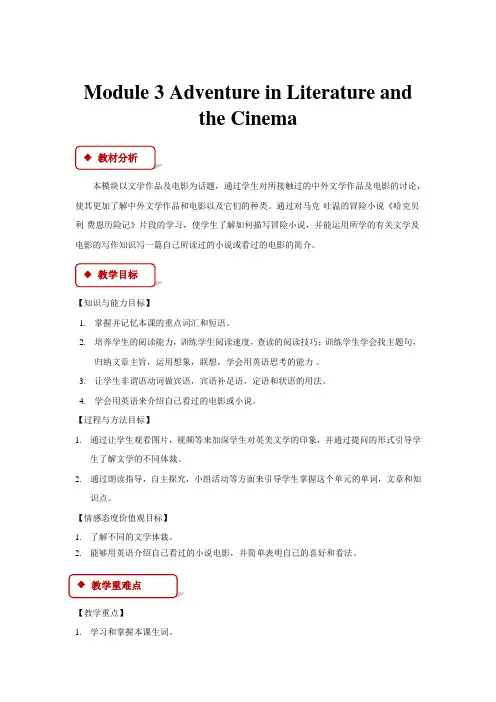
Module 3 Adventure in Literature andthe Cinema本模块以文学作品及电影为话题,通过学生对所接触过的中外文学作品及电影的讨论,使其更加了解中外文学作品和电影以及它们的种类。
通过对马克·吐温的冒险小说《哈克贝利·费恩历险记》片段的学习,使学生了解如何描写冒险小说,并能运用所学的有关文学及电影的写作知识写一篇自己所读过的小说或看过的电影的简介。
1.掌握并记忆本课的重点词汇和短语。
2.培养学生的阅读能力,训练学生阅读速度,查读的阅读技巧;训练学生学会找主题句,归纳文章主旨,运用想象,联想,学会用英语思考的能力。
3.让学生非谓语动词做宾语,宾语补足语,定语和状语的用法。
4.学会用英语来介绍自己看过的电影或小说。
【过程与方法目标】1.通过让学生观看图片,视频等来加深学生对英美文学的印象,并通过提问的形式引导学生了解文学的不同体裁。
2.通过朗读指导,自主探究,小组活动等方面来引导学生掌握这个单元的单词,文章和知识点。
【情感态度价值观目标】1.了解不同的文学体裁。
2.能够用英语介绍自己看过的小说电影,并简单表明自己的喜好和看法。
【教学重点】1.学习和掌握本课生词。
2.让学生掌握非谓语动词做宾语,宾语补足语,定语和状语的用法。
【教学难点】1.多层次的训练阅读能力,提高阅读水平2.怎样让学生灵活使用词汇、短语和句型来做题。
PPT、录音机等Step 1 Introduction1. Lead-inT: As I know, most of you have a good habit of reading books in your spare time. Who would like to tell me your favorite books? And why do you like them?S: My favorite book is The Dream of The Red Mansion. It introduces us not only a love story but also people’s life of Qing Dynasty. We can know more about Qing Dynasty by reading it. The book is also one of the most famous Chinese novels.S: I like reading Harry Potter and the Half-Blood Prince very much, which is written by J. K. Rowling. It is a book full of magic. At the same time, the book tells us justice can defeat vicious force no matter what happens. And Harry Potter is one of the most popular books all over the world.2. Warming upT: Very good! Then I have a question: How many different types of books do you know?Ss: Autobiography, crime...T: Please open your books and turn to page 21. Look at the words in the box which all describe the types of books. Please match them with their meanings.A few minutes later, check the answers.3. Pair-work: which book would you like to read and why? (Activity 1, P21)1). The teacher shows three short passages about the three books in activity 1Wolves of the Calla: The remote town, Calla, is best known for twins. Unfortunately, every ten years, some bad guys dressing up as wolves come to take away a child from each pair of the。

Module3 Reading教学设计课程分析本课是外研版必修5第三模块中的第一课时。
这一模块的标题为《Adventure in Literature and the Cinema》,主题为文学和电影中的冒险故事。
阅读文章选自马克、土温的名著《The Adventures of Huckleberry Finn》,课文是从中节选的一部分并简化改写,本文中心明确,以汽船为线索,描写两个美国孩子,哈克和吉姆在冒险旅行过程中发现汽船、登上汽船、离开汽船的过程。
以小故事的形式展现在学生面前。
通过续写故事和评价哈克及他的朋友,使学生提高调控语言的能力。
学情分析:教学对象为高中二年级学生,智力发展趋于成熟。
他们的认知能力比高一阶段有了进一步的发展,渐渐形成用英语获取信息、处理信息、分析问题和解决问题的能力,因此我特别注重提高学生用英语进行思维和表达的能力。
通过任务型课堂活动和学习,使学生的学习自主性得到加强,不再认为英语的课堂学习很枯燥,主动参与到活动中去,成为课堂的主体,同时也加强了与他人交流合作的能力。
不过,学生对于马克土温的这一作品并不是很熟悉。
所以,在上这一节课之前,我让学生在尽可能多在课外读物中或者网络上涉猎一些有关马克土温作品类型的信息。
这样,在学生具有一定的文化知识背景,并在对reading这篇文章做到充分预习的基础上,能够熟练运用英语表达自己的看法。
而且本班学生的属于文科普通班,水平参差不齐,有些差距还相当大。
因此在教学过程中,布置的任务要兼顾各个层次的学生,使他们都有所收获。
设计思路:根据诱思探究的教学理念,课堂上必须以学生为主体来进行教学,教师起引导作用,结合本课的阅读文章是节选自马克、土温的名著The Adventures of Huckleberry Finn中的一个小故事,所以我以小故事的发展为线索,通过问题情景,步步设疑,引导学生把握文章,并培养学生的语言运用能力。
因此本节课打算如此展开:首先:预测文章,激发兴趣。

Module3 Reading and Vocabulary精品教案Teaching objectives:To enable the students to catch the main idea of the reading passage Teaching methods: Reading with practiceStep 1: IntroductionActivity 1: ① Work in pairs and discuss the pictures② Ask students to answer them individually.Activity 2: Match the types of book with their meanings.Activity 3: Work in pairs, and find more examples of each type.Activity 4: Read the passage and say what type of book it describes. Step 2: Pre-readingLook at the picture. Think about what Huck and Jim will do.Step 3: While-readingThis passage can be divided into 4 parts.Paragraph 1.1. What was the weather like that night?2. What did they see as they were sailing down the river?3. What did they do then?Paragraph 2-5.1. What did Huck want to do?2. What did they hear after they got on the steamboat?Paragraph 6-8.1. What did the men on the steamboat do with another man?2. How did they decide to kill him?Paragraph 9-11.1. What did Huck decided to do after he heard they would leave the man onthe steamboat to die?2. What was the idea Huck told to Jim?3. Why did Huck feel bad about what he had done?Step 4: Post-readingFinish the Activity2-6 on Page 22-23. Step 5: HomeworkPreview the language points.。
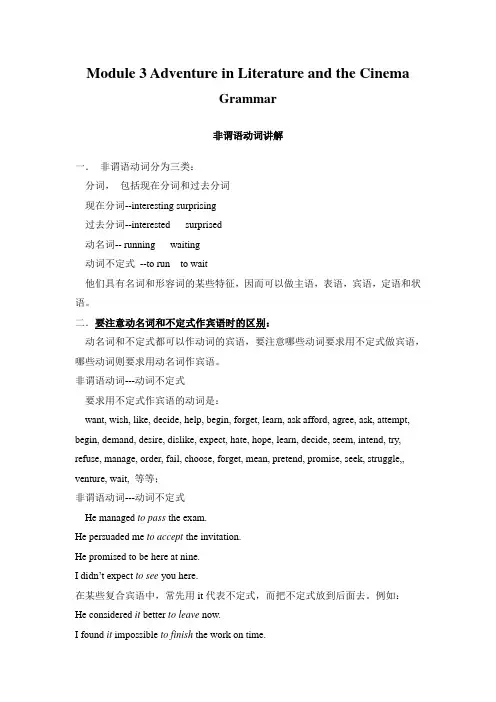
Module 3 Adventure in Literature and the CinemaGrammar非谓语动词讲解一.非谓语动词分为三类:分词,包括现在分词和过去分词现在分词--interesting surprising过去分词--interested surprised动名词-- running waiting动词不定式--to run to wait他们具有名词和形容词的某些特征,因而可以做主语,表语,宾语,定语和状语。
二.要注意动名词和不定式作宾语时的区别:动名词和不定式都可以作动词的宾语,要注意哪些动词要求用不定式做宾语,哪些动词则要求用动名词作宾语。
非谓语动词---动词不定式要求用不定式作宾语的动词是:want, wish, like, decide, help, begin, forget, learn, ask afford, agree, ask, attempt, begin, demand, desire, dislike, expect, hate, hope, learn, decide, seem, intend, try, refuse, manage, order, fail, choose, forget, mean, pretend, promise, seek, struggle,, venture, wait, 等等;非谓语动词---动词不定式He managed to pass the exam.He persuaded me to accept the invitation.He promised to be here at nine.I didn’t expect to see you here.在某些复合宾语中,常先用it代表不定式,而把不定式放到后面去。
例如:He considered it better to leave now.I found it impossible to finish the work on time.非谓语动词---动词不定式由only, last, next 序数词或形容词最高级修饰的名词常用不定式做定语; 不定式还可用作名词或代词的的宾语She is always the first student to arrive at school.He is always the last one to leave the office.I don’t think he is the best man to do the job.I have no desire to travel.You’ll find something to interest you here.There is no need to bother him with such trifles.非谓语动词---动词不定式不带to 的动词不定式在有些使役动词及感官动词后可用省略to的动词不定式,如let, make, have, hear, see, feel, smell, hear, watch等。
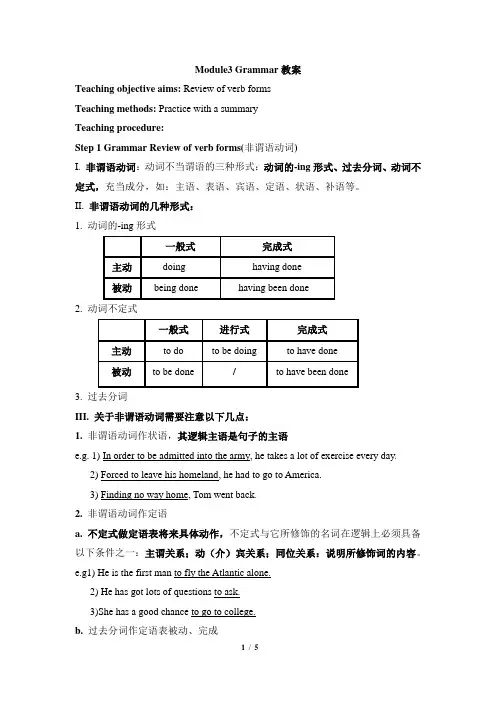
Module3 Grammar教案Teaching objective aims: Review of verb formsTeaching methods: Practice with a summaryTeaching procedure:Step 1 Grammar Review of verb forms(非谓语动词)I. 非谓语动词:动词不当谓语的三种形式:动词的-ing形式、过去分词、动词不定式,充当成分,如:主语、表语、宾语、定语、状语、补语等。
II. 非谓语动词的几种形式:1. 动词的-ing形式2. 动词不定式3. 过去分词III. 关于非谓语动词需要注意以下几点:1. 非谓语动词作状语,其逻辑主语是句子的主语e.g. 1) In order to be admitted into the army, he takes a lot of exercise every day.2) Forced to leave his homeland, he had to go to America.3) Finding no way home, Tom went back.2. 非谓语动词作定语a. 不定式做定语表将来具体动作,不定式与它所修饰的名词在逻辑上必须具备以下条件之一:主谓关系;动(介)宾关系;同位关系:说明所修饰词的内容。
e.g1) He is the first man to fly the Atlantic alone.2) He has got lots of questions to ask.3)She has a good chance to go to college.b.过去分词作定语表被动、完成e.g. The experiment done in July proved the theory true.c.动词-ing形式作定语表主动、进行e.g. The man standing at the door is a new comer.=The man who is standing at the door is a new comer.3.不定式和-ing形式皆可作结果状语,但不定式表意想不到的结果, -ing形式表自然而然的结果。
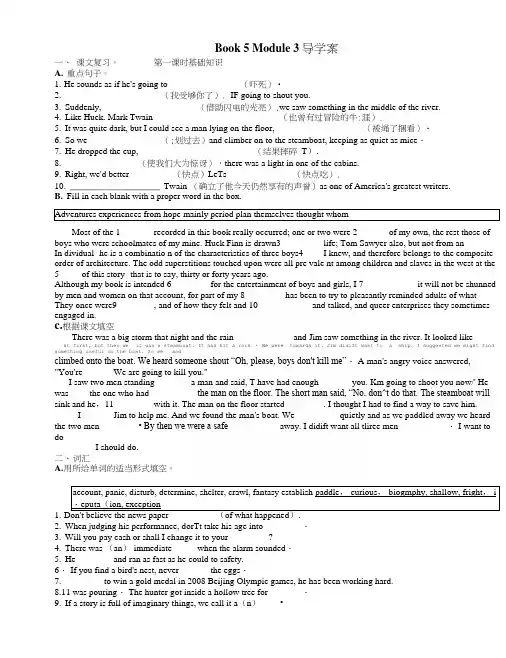
Book 5 Module 3 导学案一、课文复习。
第一课时基础知识A.重点句子。
1.He sounds as if he's going to _______________ (吓死)•2. ____________________ (我受够你了). IF going to shout you.3.Suddenly, ____________________ (借助闪电的光亮),we saw something in the middle of the river.4.Like Huck. Mark Twain ___________________________ (也曾有过冒险的牛:涯).5.It was quite dark, but I could see a man lying on the floor, __________________ (被绳了捆看)・6.So we _______________ (;划过去)and climber on to the steamboat, keeping as quiet as mice・7.He dropped the cup, ________________________ (结果摔碎T).8. _______________ (使我们大为惊讶),there was a light in one of the cabins.9.Right, we'd better _________ (快点)LeTs ______________ (快点吃).10.__________________ Twain (确立了他今天仍然享有的声誉)as one of America's greatest writers.B.Fill in each blank with a proper word in the box.Adventures experiences from hope mainly period plan themselves thought whomMost of the 1 ______ recorded in this book really occurred; one or two were 2 ______ of my own, the rest those of boys who were schoolmates of my mine. Huck Finn is drawn3 _________ l ife; Tom Sawyer also, but not from anIn dividual- he is a combinatio n of the characteristics of three boys4 ____ I knew, and therefore belongs to the composite order of architecture. The odd superstitions touched upon were all pre vale nt among children and slaves in the west at the 5 ___ of this story- that is to say, thirty or forty years ago.Although my book is intended 6 ________ for the entertainment of boys and girls, I 7 ___________ it will not be shunned by men and women on that account, for part of my 8 ________ has been to try to pleasantly reminded adults of what They once were9 _______ , and of how they felt and 10 ___________ and talked, and queer enterprises they sometimes engaged in.c.根据课文填空There was a big storm that night and the rain ____________ and Jim saw something in the river. It looked like at first, but then we it was a steamboat. It had hit a rock ・ We were towards it. Jim didift want to a ship. I suggested we might find something useful on the boat. So we andclimbed onto the boat. We heard someone shout “Oh, please, boys don't kill me”・ A man's angry voice answered, "You're ______We are going to kill you."I saw two men standing _______ a man and said, T have had enough ______ you. Km going to shoot you now/' He was ___ the one who had __________ the man on the floor. The short man said, “No, don^t do that. The steamboat will sink and he,11 _______ with it. The man on the floor started ________ . I thought I had to find a way to save him.I _______Jim to help me. And we found the man's boat. We _________ quietly and as we paddled away we heard the two men ________ • By then we were a safe__________ away. I didift want all tliree men __________ ・ I want to do________ I should do.二、词汇A.用所给单词的适当形式填空。
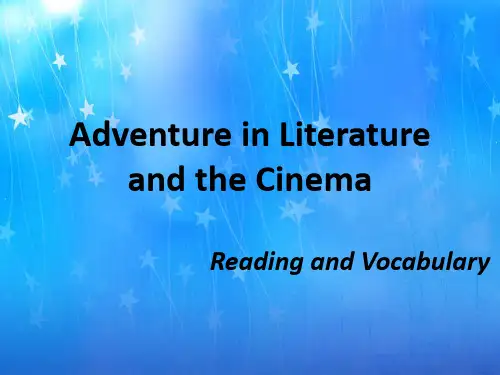
Unit3 Reading and vocabulary 名师教学设计1教学目标知识目标:Grasp the following words: pour, shelter, paddle, lie, panic, curious, tie, rope, beard, fright, crawl, terrified, trunk.能力目标:Students can listen to and understand the plot of the story and description of the characters ; They can tell the adventures using the words and phrases learnt in this module; They also can understand the story and infer the meanings of some words as well as understand adventure stories of the same level.情感态度价值观:Learn about the famous good writings and writers from China and other countries. 2学情分析The students have a vocabulary of about 2500 words . They can understand the story to some degree. They are very interested in adventures. But they are still lack of the ability to infer.3重点难点重点:Understand the plot of the story and the characters.难点:Make some inference according to the story.4教学过程4. 1第一学时4. 1. 1教学活动活动1【导入】The SteamboatDo some warming up exercises.Do you like reading?What kind of book do you like? Why?Can you tell the class the name of the book you like best?活动2【讲授】pre-readingLook at the covers of the books and guess what type of books they are.thriller, history, fantasy, biography, detective, crime, adventure活动3【讲授】while reading1. read while listening to the recording of the passage.2. read in detail.A: read Para 1 and answer questions.B: read Para 2-5 and answer questionsC: read Para 6-8 and answer questions.D: read Para 9-11 and answer questions3. Do True or False exercises4. Number the events in the order in which they happen5. Fill in the table6. Find words in the passage which mean:7. Do 4 reading comprehension exercises活动4【活动】post-reading1. Make a summary of the passage and fill in the blanks2. Complete the sentences with the words in the box.3. Analyse the character of the two boys :Huck and Jim.4. Discussion : what will happen next and continue the story 活动5【作业】homeworkWrite a passage to add your end to the story。
The Second Period GrammarTeaching goals教学目标1. Target language目标语言a. 重点词汇及短语sail, sinking, frightened, position, excite, satisfy, persuade, particularly, cabin, outline, alongside, approach, disturb, comedy, romantic, fiction, review, get away, play a trick on, look up, make up, draw up, start off, die ofb. 重点句式He agreed to...I don’t want to board a sinking ship.I could see a man lying on the floor.We heard the two men shouting.The frightened man started crying.Jim looked terrified.It looked like...It looks as if...2. Ability goals能力目标a. Enable the students to summarize the usage of verb forms.b. Enable the students to use link verb + as if / like / adjective.3. Learning ability goals学能目标a. Help the students to summarize the usage of verb forms.b. Help the students to learn how to use the correct form (-ing, -ed, or to + infinitive) of verbs.Teaching important points教学重点a. Enable the students to summarize the usage of verb forms.b. Enable the students to use link verb + as if / like / adjective.Teaching difficult points教学难点How to teach the students to use the verb forms correctly.Teaching methods教学方法Question and answer activity; pair work or group work; comparison method.Teaching aids教具准备A computer, a projector and some slides.Teaching procedures &ways教学过程与方式Step I RevisionT: Yesterday we’ve learnt a passage “The Steamboat”. Who would like to retell it briefly?S: Let me try. One day, the weather was bad and the rain poured down after midnight. Huck and Jim stayed inside the shelter they had built. Then they found a steamboat in the middle of the river when they sailed down the river. The steamboat hit a rock and was half in and half out of the water. In order to find something useful on the boat, Huck and Jim climbed onto the sinking steamboat. To their astonishment, they heard someone shout, “Oh please boys, don’t kill me! I won’t tell anybody!”A man’s angry voice answered, “You’re lying. You said that the last time. We’re going to kill you.”When they heard these words, Jim ran back to the raft because of fright. But Huck went on observing what happened there. There were three men in a cabin. The tall man was pointing a gun at the man on the floor. The short man suggested leaving the man on the floor. Then Huck had a plan. He crawled along the deck, found Jim and told him what he had heard. They decided to steal the men’s boat. Huck persuaded Jim to help him although Jim was terrified. At last, Huck and Jim took away the men’s boat. That’s all.T: Well done!Then check the answers to Exercises 4-6 on page 80 with the whole class.A sample to Exercise 6:A: Have you read the book Gone with the Wind?B: Sorry. I haven’t read it yet. Is it a book worth reading?A: Of course. It is one of the popular books all over the world. I like Scarlett, one of the heroes of it. She had something strong and special on her, such as great determination, strong willpower, etc. Once she decided to do something, she never gave it up and stuck to it until she reached her goals. And through it, you can learn something about the Civil War of America.B: Sounds wonderful. I will read it.Step II GrammarTask 1 This step is intended to help the students to summarize the verb forms by themselves. Present some sentences and encourage the students to observe the verb form of each sentence.T: Now let’s come to Grammar. I’d like you to read the sentences on the screen and find out the verb form of each sentence.Show some sentences on the screen.1. My parents plan to travel before the Spring Festival.2. I saw them arguing in the middle of the street.3. The result is a little disappointing.4. She made her children wash their hands before eating.5. “Please let me go to school,” the boy begged.6. When he arrived home, he found his door opened.7. As a teacher, he knows how to make him understood.8. China is one of the developing countries.A few minutes later.T: In sentences, verbs may be used as the “-ing / -ed”forms or “to do”forms. Can you find out what verb form is used in every sentence?S: Number 1 “to travel”; Number 2 “arguing”; Number 3 “disappointing”; Number 4 “wash”; Number 5 “go”; Number 6 “opened”; Number 7 “understood”; Number 8 “developing”.T: Well done! Next, please read the five sentences in Activity 1 on page 24 and answer the questions below.After the students finish, ask some of them to answer the questions. Then check the answers.Sample answers:1. There are two. They are the 2nd and the 3rd sentences.2. The verb let is followed by sb. / sth. do...3. In the 4th sentence: frightened.4. The -ing form can be put in the following positions: attributive, objective and objective complement.Then let the students do Activities 2-5 and check the answers with the whole class. Task 2 This step is to help the students to review link verb + as if / like / adjective. T: Now please read the three sentences in Activity 6 and match them with a-c. Check the answers.T: Now I’d like you to do Activity 7 by yourselves.After a while.T: Time is up. Let’s answer the questions one by one.S: Number 1: The tall man sounded frightening, for he had threatened the man on the floor.S: Number 2: Although he was frightened, he also felt very curious.S: Number 3: Jim looked terrified.S: Number 4: He felt regretful, for he didn’t want all three men to die.S: Number 5: The ferryboat captain sounded surprised.T: Well done.Let the students do Activities 8 &9 on page 26 and then check the answers. Sample answers to Activity 9:1. You look as if you were ill! / You look like having caught a cold!2. I feel as if I can finish this job before Saturday.3. The teacher sounds a good and careful teacher.4. Yesterday I felt as if I were floating in the air.5. The flowers you picked for me smell good.6. This food tastes delicious.Step III HomeworkLet the students complete the exercises in Grammar of WORKBOOK and do the following exercises.巩固练习:1. The speaker raised his voice but still couldn’t make himself ______.A. hearB. to hearC. hearingD. heard2. A cook will be immediately fired if he is found ______ in the kitchen.A. smokeB. smokingC. to smokeD. smoked3. Seeing the sun ______ above the surface of the sea, we let out a shout of joy.A. to riseB. to raiseC. risingD. raising4. The missing boys were last seen ______ near the river.A. playingB. to be playingC. playD. to play5. —Let me tell you something about the journalists.—Don’t you remember ______ me the story yesterday?A. toldB. tellingC. to tellD. to have told6. The library needs ______, but it will have to wait until Sunday.A. to prepareB. preparingC. preparedD. was preparing7. —I usually go to there by train.—Why not ______by boat for a change.A. to try goingB. trying to doC. to try and goD. try goingKey: DBCABBD。
Module 3 Adventure in Literature and the CinemaI. 教学内容分析本模块的主题是文学和电影作品中冒险故事,通过马克·吐温的冒险小说《哈克贝利·芬历险记》片断的学习使学生了解如何描写冒险小说,另外通过本模块学习还要了解不同的文学作品和电影作品类型,并能运用所学过的知识仿写一篇电影或小说的简介。
最后,通过本模块的学习还要帮助学生了解文学,培养对文学的兴趣,扩大文学视野本模块从不同的文学作品类型开始,导入本模块的话题——文学和电影作品中冒险故事。
Introduction 部分通过于三本书的封面介绍了三种不同的文学作品类型并列出了有关文学作品的一些单词,让学生说出自己喜欢的类型并且利用新单词给出理由,能激发学生的好奇心。
并同通过阅读《哈克贝利·芬历险记》书评的开头效果导入整个模块的话题——文学和电影作品中冒险故事。
Reading and Vocabulary是通过马克·吐温的冒险小说《哈克贝利·芬历险记》片断的学习使学生了解如何描写冒险小说。
并通过设计的练习让学生熟悉课文内容和学会使用一些相关词汇。
Grammar部分主要复习的语法项目是动词的-ed和-ing形式,动词不定式和一些连系动词的用法。
Learning to learn是教学生如何巧计感观动词的用法,对于提高学习策略水平有很大的帮助。
Vocabulary and Listening部分第一部分设计一个学习有关电影类型的词汇的活动,第二和三部分则通过听一段关于讨论决定看电影上映的哪部电影的对话,让学生听出电影的内容猜测电影名称。
Speaking部分让以电影为话题谈论所喜欢的电影并解释理由,能根据同学提供的内容猜测电影名称。
Function要求学生掌握怎样将表示“陈述”和“建议”的直接引语变为间接引语。
Writing首先让学生读两篇小说或电影的简介,接下来要求学生运用所学过的知识仿写一篇电影或小说的简介。
Everyday English通过学习复习Vocabulary and Listening中的句子学会一些非常有用的日常生活用语:feel in the mood for something, hang on a minute, get a move on和grab a bite to eat.Cultural Corner 通过阅读The Life of Mark Twain的文章,帮助学生了解伟大作家马克·吐温的作品及其经历。
Task要求学生通过调查问卷的形式了解同学们的阅读习惯,然后汇报调查结果。
Module File 归纳了本单元的重点词汇,语法知识,功能用语和日常用语,有利于学生的复习总结,自我检验和自学的能力。
II.教学重点和难点1. 教学重点(1) 本模块的生词和短语(2) 语法项目:动词的-ed和-ing形式,动词不定式和一些连系动词的用法(3) 掌握怎样将表示“陈述”和“建议”的直接引语变为间接引语(4) 了解不同的文学作品和电影作品类型,并能运用所学过的知识仿写一篇电影或小说的简介2. 教学难点(1) 语法项目:动词的-ed和-ing形式,动词不定式和一些连系动词的用法(2) 帮助学生了解文学,培养对文学的兴趣,扩大文学视野III.教学计划经过对教材内容的分析和重组,本模块可以分六课时教授:第一课时:Introduction ,Task第二课时:Reading and Vocabulary (1)第三课时:Reading and Vocabulary (2) , Reading (Workbook)第四课时:Learning to learn, Grammar, Function第五课时:Vocabulary and Listening, Everyday English, Speaking, Writing第六课时:Cultural Corner, Workbook, Module FileIV.教学步骤:Period 1 Introduction, TaskTeaching Goals:1. To arouse Ss’ interest in learning about adventure in literature and the cinema2. To develop Ss’ speaking ability3. Enable Ss to learn more new words about the types of book4. Enable Ss to do a survey of teenage reading habits and then give a presentation Teaching Procedures:Step 1 Leading-inPurpose: To activate Ss’ and arouse them to talk about literature they know.Ask Ss to discuss the following question in group of four or five:What do you know about the literature in China?The most famous works are:《西游记》Journey to the West; Pilgrimage to the West《红楼梦》The Dreams of the Red Mansion/ Chamber; A Dream in Red Mansions; The Story of the Stone《三国演义》The Romance of the Three Kingdoms《水浒传》Heroes of the Marshes; Heroes of Water MarginsStep 2 SpeakingPurpose: To develop Ss’ speaking abilityWork in pairs. Say which book you would like to read and tell the reason.TExamples:I’d like to read Wolves of the Calla. It looks exciting.I’d like to read 1421 The Year China Discovered America, because I like history very much and I am proud of my country.I’d like to read The Singular Mark Twain, because I think he’s very awesome andextraordinary.Step 3 New words studyingPurpose: Enable Ss to learn more new words about the types of book.Individual work: Ask Ss to use dictionary and wordlist to match the types with their meanings. After that, get the Ss to read the words after you.Suggested answers1 biography2 fantasy3 adventure4 thriller5 crime6 historyStep 4 Group work (Vocabulary)Purpose: Enable Ss to find more examples of each type.Ask the students work in groups, decide what types of books are in Activity 1, and try to find more examples of each type.Step 5 Group work (Task)Purpose: Enable the Ss to do a survey of teenage reading habits and then give a presentation.Ask the students to work in groups and discuss the following questions.1 How often do you read for pleasure? (____hour/week)2 What sort of books do you like reading? (biography/ fantasy/ adventure/ thriller/ crime/ history)3 Are you reading a book at the moment? What’s the title?4 Of all the books you’ve read, which one do you like best? Why?After finish the survey, ask the students to give a presentation of the groups’ findings to the rest of the class.Step 6 Homework1. Get on the line and find out more information about a book called The Adventures of Huckleberry Fin.2. Preview Reading and Vocabulary.Period 2 Reading and Vocabulary (1)Teaching Goals:1. To learn something about The Adventures of Huckleberry Fin.2. To develop some basic reading skills—Skimming, and Scanning.3. To deal with the new words in the text.Teaching Procedures:Step 1 Leading-inPurpose: To arouse Ss’ interest in learning about The Adventures of Huckleberry Fin As the Ss have got on the line and prepared something for The Adventures of Huckleberry Fin. That’s our homework. Ask them to share the information they have found and choose a student to tell the story of The Adventures of Huckleberry Fin.Step 2 Pre-readingPurpose:To review the words we have learnt and get more information about The Adventures of Huckleberry Fin.Ask the students to turn to P21 (Introduction), and read the passage in Activity 4. Use the words in activity 2 to say what type of book it describes.Suggested answers:It gives us a brief introduction of The Adventures of Huckleberry Fin and leads us to an exciting story. The type of the book is adventure.Step 3 ScanningPurpose: To get the general idea of the text.1. Ask the Ss to turn to P22, and look at the picture. Think about what Huck and Jim will do.(Maybe they will just pass by./ They will go into the steamboat and see what happened. )2. Ask the students to scan the text and check whether it is the same as their ideas.3. Pair work: Number the events in the order they happen.Suggested answers:a4 b2 c6 d1 e8 f5 g3 h74. Work in groups and say what you think happens next.Suggested answers:They went back and saved the three men./ They went to another place and found all the people talked about a murder.Step 4 SkimmingPurpose: To get Ss to have some details in the text.1. Read the passage again and answer the questions in activity 6 individually.Suggested answers:1) c 2) b 3) a 4) a2. Read the text quickly for the second time and try to get some details from the text. While reading, underline the new words in the passage.Step 5 New words studyingPurpose: To deal with the new words in the text.1. Ask the Ss to use dictionaries to solve the new words and help them to deal with some difficult points. At last, ask the students to read after you.2. Deal with activity 4&5.Suggested answers (activity 4):1) pour down 2) a shelter 3) a raft4) panic 5) curious 6) threatenSuggested answers (activity 5):1) jump 2) running 3) flown 4) walk5) climbed 6) paddled 7) sail 8)crawlStep 6 HomeworkTry to find the difficult sentences for you in the passage.Period 3 Reading and Vocabulary (2), Reading (Workbook)Teaching Goals:1. To deal with the language points in the text.2. To read a passage named An Introduction of Patrick O’Brian on P81 of workbook get some information about the novelist.Teaching Procedures:Step 1 Leading-inPurpose: To review what we learnt yesterday.Ask the Ss to retell the story that we learnt yesterday and have a dictation of the new words. Step 2 Group workPurpose: To train Ss’ listening ability and to deal with the language points in the text.Listen to the tape and deal with the language points in groups.Listen to the tape and follow it in a low voice. Then the students are divided into seven groups. Each group is supposed to read through each paragraph, and then discuss them.Paragraph 1.1. the rain pour down = rain cats and dogs 大雨倾盆pour 泼;倾倒.Eg He poured the water over the lawn. 他给草坪泼了些水.2. By the light of the lighting, we saw something in the middle of the river.通过闪电的光,我们看到河中间有个东西.by的用法:(1) through; with the help of 如例句(2) close to; next toEg the window by the door(3) pastEg We drove by the house.Paragraph 2.as if/ as though 好像;仿佛(1)用在look, feel, smell, taste或sound之后,后面从句用陈述语气Eg It looks as if it will go under soon.(2)用于引导结果状语从句时,从句用虚拟语气Eg The house was in such a mess. It looked as though a bomb had dropped on it.Paragraph 3.1. board vt.上(船),坐(船);〔美国〕搭(车);乘(飞机)。